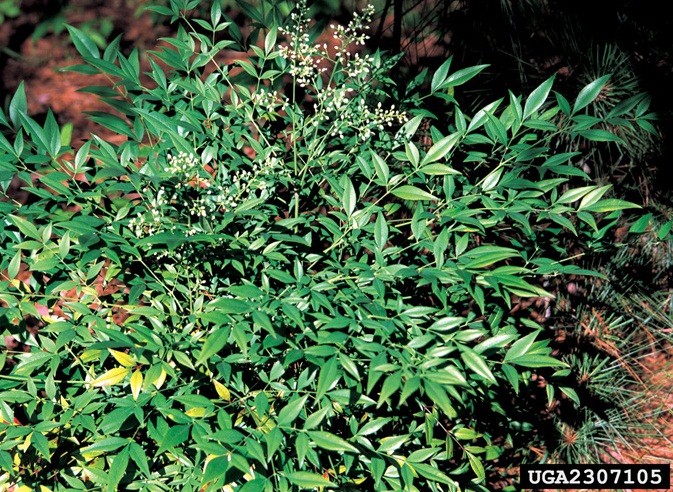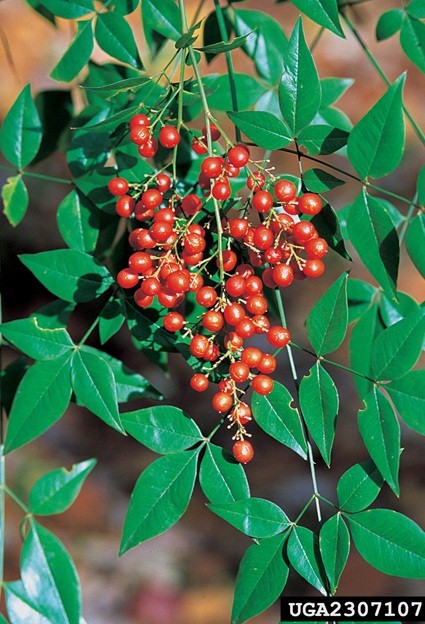Nandina domestica
Sacred Bamboo
Class: Magnoliopsida
Order: Ranunculales
Family: Berberidaceae


Photographer: James H. Miller, USDA Forest Service
Source: Bugwood. org
Description
Nandina domestica, sacred bamboo, is an evergreen shrub that grows up to 8 feet tall; and has multiple stems that resemble bamboo. The wood is bright yellow and tightly stacked near terminals. These shrubs have compound green to reddish leaves with white terminal cluster flowers and bright red berries (pictured right) in the fall and winter.
Ecological Threat: Nandina domestica has naturalized and invaded habitats ALL THROUGHOUT THE Southeastern United States; it colonizes by spreading underground root sprouts and by animal-dispersed seeds. This shrubn occurs under forest canopies and near forest edges and can persist as a seedling for several years before maturing. It can displace native species and disrupt plant communities. By interfering with ground covering plants it is able to alter an ecosystem and impact native animals that use native understory plants. Also, the berries are toxic to cats and some grazing animals.
Biology: This plant flowers from May to June and produce fruits from September to April. Seeds ripen in late winter germination and can remain viable for up to 1 year.
History: Originally was brought to the United States as an ornamental in the 1800s and has spread throughout the Southeastern United States.
U.S. Habitat: It is shade tolerant and can inhabit several types of plant communities from upland hardwoods to floodplain forests or slope woodlands.
Distribution
Native Origin: Asia including India, China and Japan
U.S. Present: AL, FL, GA, LA, MS, NC, SC, TN, TX and VA
Management
The best management strategy is preventative methods such as not planting, removing prior plantings, and control sprouts and seedlings. Manual removal of small plants works when the soil is moist; but fruits must be bagged and disposed of fruit in a dumpster or burned and removal of all roots in necessary. Chemical treatment works also. For treatments from August to October it is suggested to thoroughly wet all leaves with glyphosate herbicide as a 1% solution in water. Also one can apply a basal spray of Garlon 4 (Triclopyr) as a 20% solution in a labeled basal oil product (such as: vegetable/mineral oil with a penetrant, or diesel); or apply undiluted Pathfinder II (Triclopyr). For the treatment of large stems the must be cut and stump tops treated immediately with a glyphosate herbicide and water.
Text References
Boyce, Richard L. 2009. Invasive shrubs and forest tree regeneration. Journal of Sustainable Forestry. 28(1-2): 152-217.
Miller, J. H. 2003. Nonnative invasive plants of southern forests. A Field Guide for Identification.
Internet Sources
http://www.invasivespeciesinfo.gov/plants/sacredbamboo.shtml
http://plants.usda.gov/core/profile?symbol=NADO
http://www.na.fs.fed.us/fhp/invasive_plants/weeds/nandina.pdf
 Texas Invasive Species Institute
Texas Invasive Species Institute